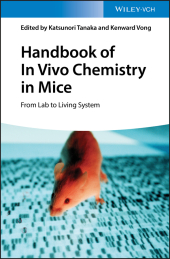 Neuerscheinungen 2020Stand: 2020-02-01 |
Schnellsuche
ISBN/Stichwort/Autor
|
Herderstraße 10
10625 Berlin
Tel.: 030 315 714 16
Fax 030 315 714 14
info@buchspektrum.de |

Katsunori Tanaka, Kenward Vong
(Beteiligte)
Handbook of In Vivo Chemistry in Mice, 2 Vols.
From Lab to Living System
Herausgegeben von Tanaka, Katsunori; Vong, Kenward
1. Auflage. 2020. 576 S. 223 SW-Abb., 133 Farbabb. 244 mm
Verlag/Jahr: WILEY-VCH 2020
ISBN: 3-527-34432-2 (3527344322)
Neue ISBN: 978-3-527-34432-1 (9783527344321)
Preis und Lieferzeit: Bitte klicken
Provides timely, comprehensive coverage of in vivo chemical reactions within live animals
This handbook summarizes the interdisciplinary expertise of both chemists and biologists performing in vivo chemical reactions within live animals. By comparing and contrasting currently available chemical and biological techniques, it serves not just as a collection of the pioneering work done in animal-based studies, but also as a technical guide to help readers decide which tools are suitable and best for their experimental needs.
The Handbook of In Vivo Chemistry in Mice: From Lab to Living System introduces readers to general information about live animal experiments and detection methods commonly used for these animal models. It focuses on chemistry-based techniques to develop selective in vivo targeting methodologies, as well as strategies for in vivo chemistry and drug release. Topics include: currently available mouse models; biocompatible fluorophores; radionuclides for radiodiagnosis/radiotherapy; live animal imaging techniques such as positron emission tomography (PET) imaging; magnetic resonance imaging (MRI); ultrasound imaging; hybrid imaging; biocompatible chemical reactions; ligand-directed nucleophilic substitution chemistry; biorthogonal prodrug release strategies; and various selective targeting strategies for live animals.
-Completely covers current techniques of in vivo chemistry performed in live animals
-Describes general information about commonly used live animal experiments and detection methods
-Focuses on chemistry-based techniques to develop selective in vivo targeting methodologies, as well as strategies for in vivo chemistry and drug release
-Places emphasis on material properties required for the development of appropriate compounds to be used for imaging and therapeutic purposes in preclinical applications
Handbook of In Vivo Chemistry in Mice: From Lab to Living System will be of great interest to pharmaceutical chemists, life scientists, and organic chemists. It will also appeal to those working in the pharmaceutical and biotechnology industries.
CHAPTER 1: SUMMARY OF CURRENTLY AVAILABLE MOUSE MODELS
CHAPTER 2: GENERAL NOTES OF CHEMICAL ADMINISTRATION TO LIVE ANIMALS
CHAPTER 3: OPTICAL-BASED DETECTION IN LIVE ANIMALS
CHAPTER 4: ULTRASOUND IMAGING IN LIVE ANIMALS
CHAPTER 5: POSITRON EMISSION TOMOGRAPHY (PET) IMAGING IN LIVE ANIMALS
CHAPTER 6: SINGLE-PHOTON EMISSION COMPUTED TOMOGRAPHIC IMAGING IN LIVE ANIMALS
CHAPTER 7: RADIOTHERAPEUTIC APPLICATIONS
CHAPTER 8: METABOLIC GLYCAN ENGINEERING IN LIVE ANIMALS: USING BIOORTHOGONAL CHEMISTRY TO ALTER CELL SURFACE GLYCANS
CHAPTER 9: IN VIVO BIOCONJUGATION USING BIO-ORTHOGONAL CHEMISTRY
CHAPTER 10: IN VIVO TARGETING OF ENDOGENOUS PROTEINS WITH REACTIVE SMALL MOLECULES
CHAPTER 11: IN VIVO METAL CATALYSIS IN LIVING BIOLOGICAL SYSTEMS
CHAPTER 12: CHEMICAL CATALYST-MEDIATED SELECTIVE PHOTOOXYGENATION OF PATHOGENIC AMYLOIDS
CHAPTER 13: NANOMEDICINE THERAPIES
CHAPTER 14: PHOTOACTIVATABLE TARGETING METHODS
CHAPTER 15: PHOTOACTIVATABLE DRUG RELEASE METHODS FROM LIPOSOMES
CHAPTER 16: PEPTIDE TARGETING METHODS
CHAPTER 17: GLYCAN-MEDIATED TARGETING METHODS


